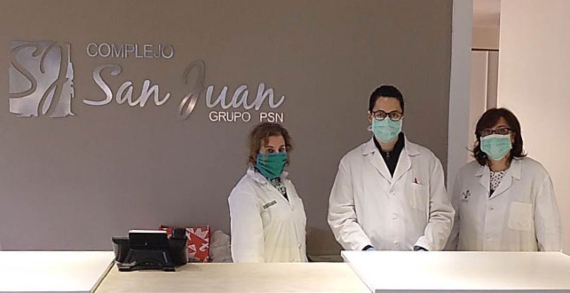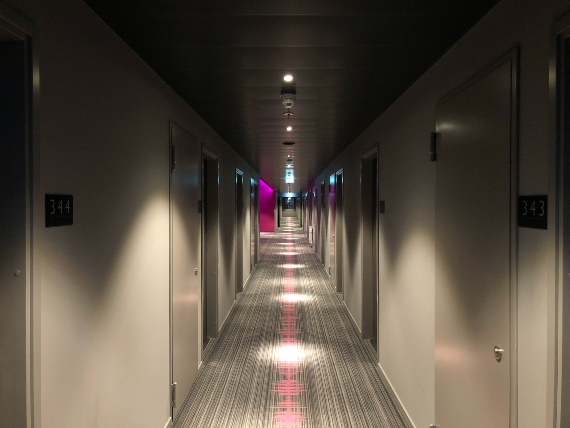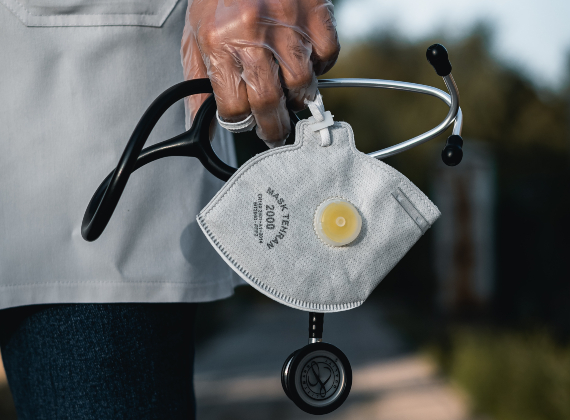Rafael Pinilla is a physician and economist and has extensive experience at the National Institute of Social Security (INSS). He was also one of the founders of the telemedicine platform Qoolife, so he is familiar with the world of information technologies applied to health care. With a resume like this, it isn’t hard to understand why Rafael Pinilla was selected as the Medical Coordinator at the Dr. Perez Mateos Medical Hotel in Alicante.

In the middle of the health emergency to stop the spread of COVID-19, some countries have used private facilities, like hotels, to expand their capacity to provide medical services. OpenMind spoke with Rafael so that he could share his experience as a manager in this unprecedented crisis. What can medicine learn from a massive experiment like this?
Do you recall any other time in history when hotels were used for medical purposes in order to reinforce the healthcare services in Spain? Or is this an unprecedented situation?
I don’t know if this resource has been used before in Spain, but in the current circumstances it was a clear solution. Our country has excellent hotel infrastructure and it was no longer housing tourists. The fastest way to expand the healthcare system’s ability to care for infectious patients was to take advantage of this infrastructure.
How was the decision made about whether a hotel is suitable to be converted into a medical hotel? Does it have to meet certain criteria or can any hospital be reconverted?
The most important aspect is that it has conditions to isolate patients and can be reorganized to separate the clean zone from the contaminated zone. Many hotels meet these conditions.
What basic characteristics does a medical hotel have, and how is it different from a hospital?
n the context of this epidemic, a medical hotel is specialized in treating COVID-19 patients. The patients stay in isolation in individual rooms. In other words, they cannot leave their room or receive visitors. In all cases, they are patients with mild symptoms or people who are asymptomatic. If there were able to be isolated at home they wouldn’t need to be at the hotel. But there are people who cannot self-isolate properly at home because their home does not have the right conditions, or they live with vulnerable family members, or could be a risk to the community. These patients are better at the hotel, and it is safer for everyone.
The biggest difference between a medical hotel and a hospital is the equipment, and the number of healthcare workers at the hotel is the minimum necessary. This way we can increase the capacity to care for patients at a quality accomodation and a lower cost.
During the reconversion process, what are the technical and hygiene aspects that require special attention?
Reconversion is a word that sounds like a major transformation, when in reality it is just a reorganization that we know will be temporary. When the peak of the epidemic passes, the hotel will return to its normal activity as accomodation for tourists. So everything that could be damaged must be removed from the rooms and replaced with equipment provided by referral hospital. For example, the hotel’s mattresses and bedding were replaced with material from the Alicante General Hospital, the hospital on which the medical hotell depends for its management. It is important to define the clear separation of spaces: clean zone, contaminated zone and potentially contaminated zone. The clean zone does not require special precautions. It’s where the administrative staff is, the kitchen, storage areas for material. The contaminated zone is the patients’ rooms. The potentially contaminated zone, or the intermediate area, is where healthcare workers move around while working. The staff has to take a series of precautions with personal protective equipment when entering and leaving the rooms. We also established a decontamination protocol when leaving the hotel from the semi-contaminated zone to go outside.

You are the Medical Coordinator at the Dr. Pérez Mateos Medical Hotel. What was your role during the reorganization? What were the biggest challenges you faced? Was the fact that you are a both an economist and a doctor useful for any specific tasks?
In reality, my role was rather modest. The proprietary company (Previsión Sanitaria Nacional) and the hotel manager were extraordinarily diligent at vacating the spaces they could offer us. Alicante General Hospital’s management took care of the provision of materials and equipment. The coordinator and nursing supervisors organized the shifts for staff and trained them in record time. My role consisted of organizing the spaces, the decontamination routines to prevent infection among staff, and also recruiting a medical team (all volunteers). I am also in charge of resolving any problems that may arise, but in practice, the entire staff has organized themselves very well. They have done their best and we haven’t had any relevant problems. It’s incredible how well people work when they know what they have to do and you simply let them do it.
Being an economist gives you a greater perspective of the hotel’s role as an element of efficiency in management, and not just as a structure of preventive medicine. But any doctor with training in public health could have coordinated the hotel. It’s not hard. In my case, my training and experience in preventive medicine has been more useful than my training as an economist.
How long did it take to reorganize the hotel? How many rooms does the hotel have and what kind of patients are treated there?
They called me on Sunday, March 29th to ask me if I could take charge. The regional public health department signed an agreement with the proprietary company for the transfer of the hotel on March 30th and on April 2nd we were receiving the first patients. So it took us three or four days to open the first floor. Over the following days we continued to equip the other floors while treating the first patients. The hotel has six floors and 23 rooms on each floor, but we did not occupy more than the first two floors. We had prepared the third floor, but it was it was not used for patients because the number of people admitted started to decline before we had to open it.
As I mentioned before, all the patients at the hotel had COVID-19 with mild symptoms, or were asymptomatic.
Do you think this experience of medicalizing hotels could be repeated or will become recurrent in the future? If so, are current protocols sufficient, or should they be updated in order to adapt them to the potential risks of pandemics?
We haven’t had time to do an objective assessment of this type of structure. It was all very fast. When the emergency is over, I think it would be good to do an evaluation, combining the experience at other hotels opened in different cities to extract the lessons we have learned. It’s important to learn for the future and do so systematically. Countries that have the misfortune of having to face frequent emergency situations do this. For example, Japan has a lot of earthquakes. That’s why it has designed action plans based on previous experiences to minimize damage and victims. People receive education. They know what they have to do if there is an earthquake. This preparation surely served them to manage this pandemic. It would be very good if we were able to learn from this epidemic because sooner or later there will be another pandemic and it’s always better to have a plan ready and tested for these cases. In the case of hotels, for example, we improvised. It’s fine, but it would be better if there were already a series of hotels that had been studied and designed to be used by the healthcare system in the fastest, most efficient way possible if needed in case of a disaster. Then, we could take into account factors like proximity to the hospital that will manage it, strategic storage units with protective materials for professionals, what staff will be mobilized to take charge.
How do you think that healthcare should evolve after this pandemic to be more effective and put doctors and healthcare workers less at risk?
With a contagious disease the focus is not on protecting healthcare works, but on stopping community transmission. But precisely because the transmission chain must be broken, it is essential for professional not to be infected. It isn’t for us. It’s because hospitals and nursing homes can become very dangerous places for fragile people. Perhaps the biggest problem we have had in Spain and Italy has been the inability to prevent the infection of healthcare workers (and nursing home staff). It has turned hospitals and nursing homes into sources of infection. Professionals should have been a dam and it seems like we have become a transmission chain. We do not yet have enough data to confirm this but it seems like the most plausible hypothesis to explain why we have had such high levels of infection and deaths in Italy and Spain.

Do you think that this crisis will boost telemedicine permanently?
It seems evident that this pandemic will promote all kinds of telework – also telemedicine. And we already knew that a significant portion of the activity in the healthcare system does not require physical contact between the physician and the patient. Now we have acquired greater awareness of the fact that health centers can be dangerous places for patients and professionals. They always have been, but in Spain we had a very high level of use of healthcare services. Many older people go to the doctor ten times a year, or more. A lot of these appointments are not necessary because they are bureaucratic in nature (prescriptions, requesting appointments to see a doctor or for tests, etc.), or to monitor chronic pathologies that could be conducted better, and with less risk, remotely. Healthcare organizations have been very slow to adopt technologies, shielding themselves with data protection laws and demanding elevated security standards. The problem with these security standards is that in practice they could become a barrier to innovation, and do not even accomplish what they intend to because when they are inconvenient, people ignore the instructions. I’ll give you an example. Authorities ask us to use corporate means of communication (email, official secure platforms), but in the context of the epidemic, these limitations were evident. So professionals improvised informal communication and management systems with free tools like WhatsApp or personal emails that we can access without any problems on our cell phones. This is definitely not ideal, but it worked. And through these groups I have had access to first hand information and direct contact with Chinese and Italian doctors, which was very useful to quickly organize the medical attention at the hotel. We need to strike a balance between the hierarchical management of healthcare resources, which is clearly necessary, and the free exchange of experiences and scientific information among professionals.
Comments on this publication